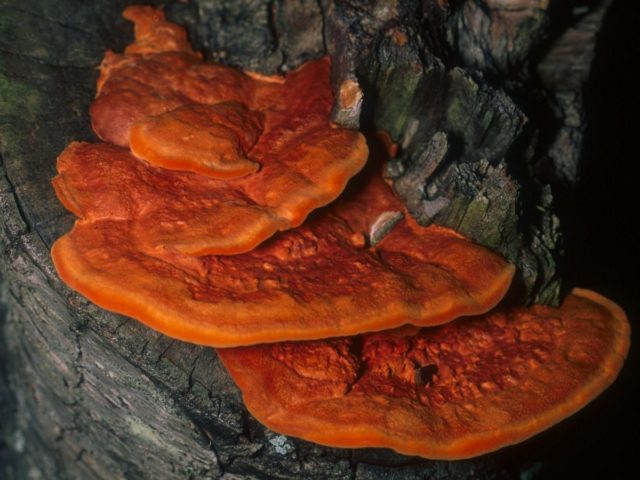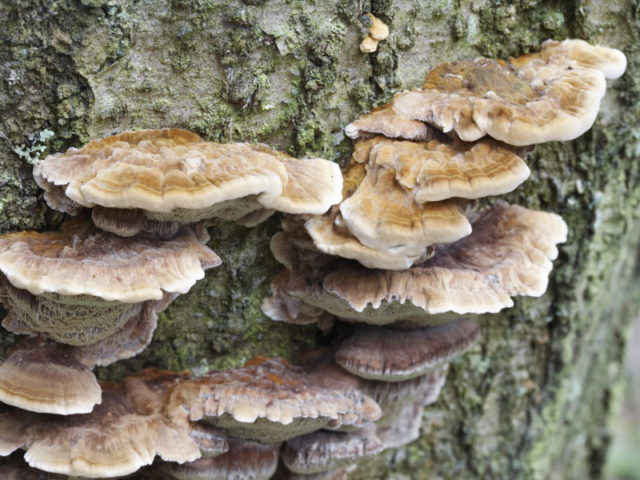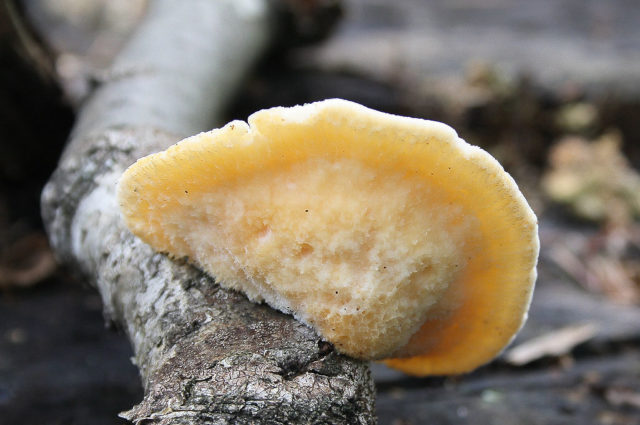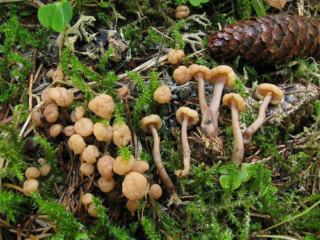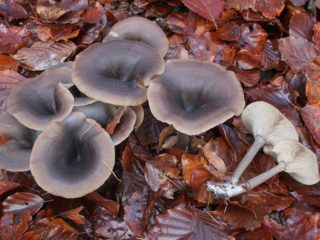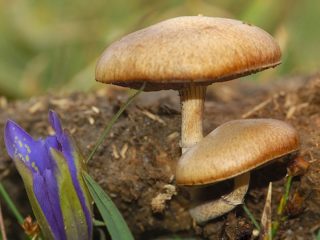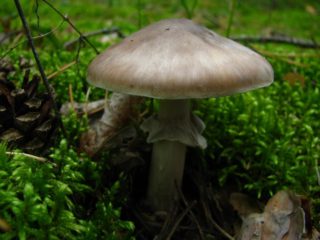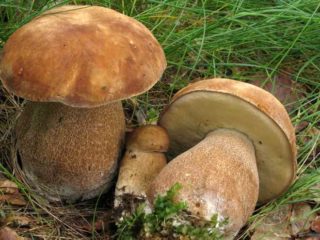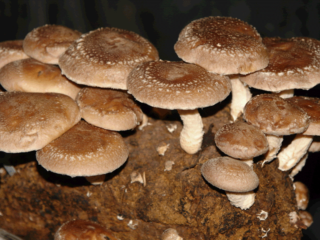Content
Pycnoporellus fulgens is a bright representative of the fungal world. In order not to confuse it with other species, you need to know what it looks like, where it grows and how it differs.
Description Pycnoporellus brilliantus
Pycnoporellus brilliantus is also known by another name - shining tinder fungus. This is a species belonging to the basiomycetes of the Fomitopsis family.
The body of the mushroom is a sessile or half-shaped fan-shaped cap, which rarely grows much. Its dimensions range from 8 cm in length to 5 cm in width. The leg is pronounced (if present). The edges are drooping, uneven, sometimes torn. The color is matte, yellowish-white, later fading to orange and crimson. The surface is smooth and shiny, sometimes with a velvety coating, closer to the base it is lumpy and rough, with light or almost white borders of the cap.
The inner layer is fleshy, large-porous, sometimes dissected in older specimens. Over time, it is susceptible to destruction, rotting and insect attack. The pores are filled with a pale gray powder, long, irregular in shape, often with split or ragged edges. The color ranges from beige to pale orange, becoming lighter towards the edges.
When broken, a fresh mushroom emits a pungent, rare smell. The center is dense, fibrous, yellowish or creamy. When dried, the pulp becomes brittle and brittle.
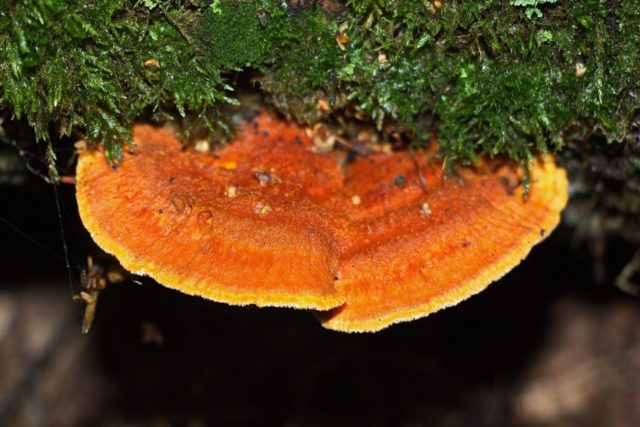
Colonies of Pycnoporellus lucidum often infect wood that is already parasitized by other species of organisms.
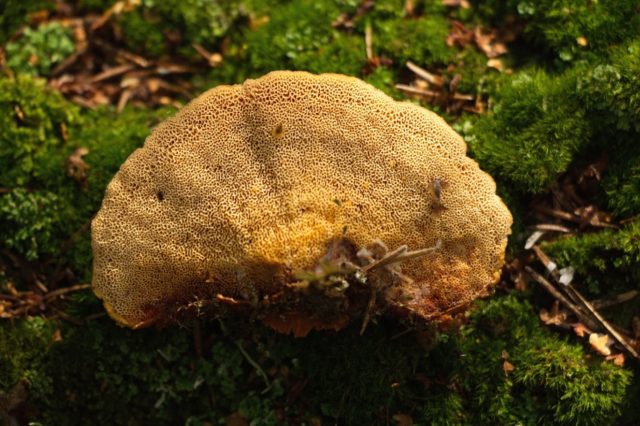
The bright color makes the brilliant pycnoporellus stand out against the background of forest greenery
Where and how does it grow
Pycnoporellus splendor grows mainly in spruce forests, mixed forests, on dead wood (pine, spruce, fir), less often on the trunks of dead deciduous trees (aspen, birch, oak). Loves high humidity, shade, parasitizes on dead colonies of other fungi.
In Russia, Pycnoporellus brilliantis is widespread in the Nizhny Novgorod region, appears from the beginning of summer, grows until late autumn. It is also found in the Leningrad region - north-west of St. Petersburg, but not very often.
Is the mushroom edible or not?
Pycnoporellus brilliantis has a mild taste. No data on consumption are documented. In medicine, an extract from the body of Pycnoporellus lucidum is used to combat pathogenic bacteria of the genus Candida. There is unverified evidence that Pycnoporellus lucidum, when consumed raw, has a weak inhibitory effect on the nervous system and causes hallucinations.
Doubles and their differences
Pycnoporellus splendor can easily be confused with similar species of mushrooms:
- The cinnabar-red tinder has similar external characteristics: a sessile round fruit body up to 2 cm thick and up to 12 cm in diameter. Young specimens are painted in bright carrot, red, and orange shades. As it grows and ages, the color changes to ocher or brownish-carrot color. The pulp is corky, the surface on young mushrooms is velvety, on old ones it is rough. It is an annual representative of the fungal kingdom, but spores can persist for a long time in the ground or wood. Not edible. It differs from Pycnoporellus lucidum in its brighter color, pore size and branched edges.
The vermilion tinder fungus serves as a food source for many forest insects.
- Inonotus radiata. An annual mushroom 3-8 cm long and 2 cm wide. It grows from the middle to tree trunks and forms colonies. The fan-shaped hat is brownish-red, pale beige, brownish. The edges are torn and broken. The surface is wrinkled, knotty, striated, and protruding here and there. The pulp is fibrous, corky in structure, when crushed it turns brown and releases a yellowish liquid. The mushroom is inedible. It differs from Pycnoporellus brilliantis in color, location and method of growth (rows or tiers).
Inonotus radiata grows freely on rotten or half-dead trunks of alder, linden and even birch
- Tyrometses kmeta. The fruiting body is small, sessile, attached throughout the entire structure, and thin. Up to 6 cm in diameter and up to 1 cm thick. The borders are dense, sometimes ciliated. The color of young specimens is almost white, sometimes in milky or creamy tones, but with age it becomes orange or turns brown. The surface is rough, medium pubescent. The pulp is watery and soft. The pores are small and uneven.It grows only on dead wood of deciduous trees - this differs from Pycnoporellus brilliantus. Rare species, inedible.
Tyrometses kmeta resembles a slice of lemon or other citrus fruit attached to a tree
Conclusion
Pycnoporellus brilliantis is an amazing representative of its family, but little studied and not suitable for consumption. It has several duplicates, differing in place of growth and some external characteristics.
https://www.youtube.com/watch?v=zA6ZZ8VZRbI
